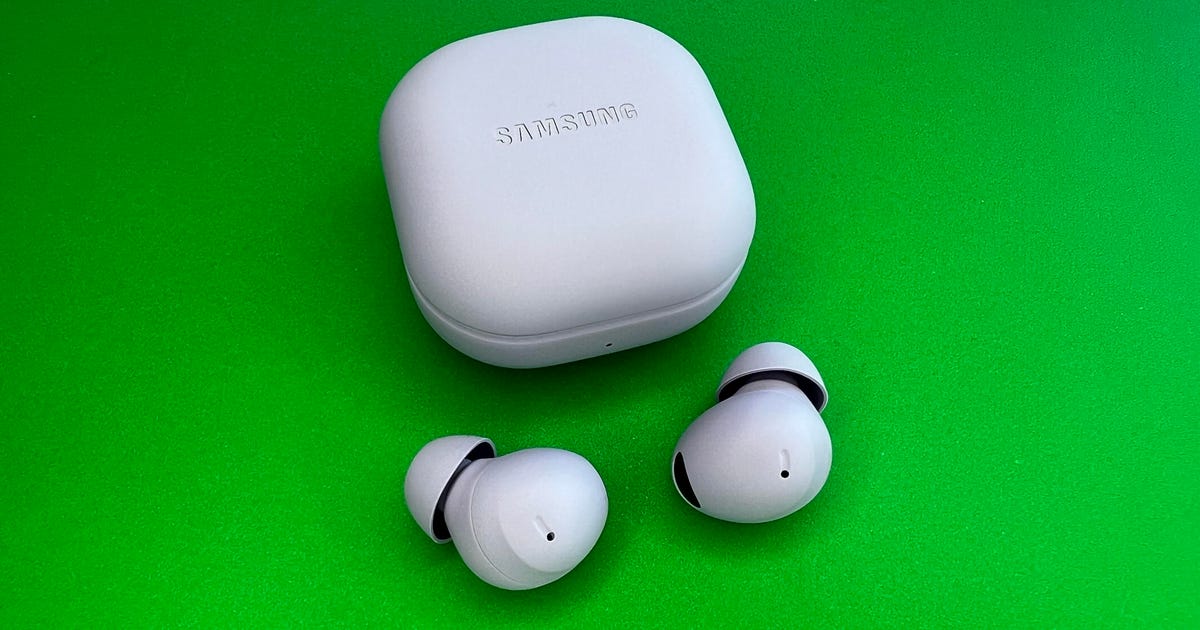
Samsung Galaxy Buds 2 Pro Review: Improved Design Pays Dividends
When Samsung launched its unique Galaxy Buds Pro noise-canceling earbuds, one of its headline marketing messages was the attention it paid to their still quality. Indeed, they delivered on that front, but a perilous subset of users, including me, found them to be a less than ideal fit for their ears. In my case, none of the concerned ear tips allowed me to get a tight seal, so I had to swap in a larger set of tips from a rival set of earbuds. So, needless to say, I was curious to see what Samsung's engineers had come up with for the second-gen Galaxy Buds 2 Pro ($230, £219, AU$349), suspecting they'd address that fit issue.
Like
Improved execute with more comfortable fit
Excellent tranquil and good noise canceling
Very good voice-calling performance
Assortment of fantastic features for Galaxy device owners, including 360 Audio virtual surround tranquil and hands-free Bixby voice assistant
Fully waterproof (IPX7)
Don't Like
Fairly pricey
Some key features only work with Samsung devices
No true multipoint Bluetooth pairing
Sure enough, they did. The first thing you'll notice about the Samsung Galaxy Buds 2 Pro -- which are launching in contradiction of the new Samsung Galaxy Z Flip 4 and Galaxy Z Fold 4 -- is that they naively have a better all-around design than their predecessor. Not only are they 15% smaller, according to Samsung, but they weigh slightly less (5.5 grams per bud versus 6.3 grams) and have a matter finish on both the buds and case that allows them a nicer feel and makes them a bit more grippy.
Read more: Best Wireless Earbuds for 2022
That establishes the compact case a little less likely to slip out of your hand and -- more importantly -- it helps keep the buds in your ears a minor more securely. And thanks to their new shape and smaller size, I was able to get a tight seal with the largest set of implicated ear tips and didn't have to supply my own. Additionally, the earbuds don't stick out of your ears as much as the novel Galaxy Buds Pro did, and they look more discreet. They're available in three colors -- Bora purple, white and graphite -- and after I can't say they'll fit all ears equally well, they necessity provide a better fit to more ears than the novel Galaxy Buds Pro.
Proprietary high-res audio and other Galaxy-exclusive features
Aside from the revamped execute, Samsung is touting the buds' improved noise canceling and serve for 24-bit high-resolution audio. The catch is to get that 24-bit audio you'll need a Galaxy arrangement equipped with Samsung's One UI 4.0 and a music streaming service like Qobuz, Tidal or Amazon Music that floods high-res audio tracks. On all other devices, including Android phones and iPhones, the buds default to the AAC audio codec. They use Bluetooth 5.3.
Alas, the Galaxy Buds 2 Pro don't support the more favorite AptX Adaptive audio codec for Android devices, only the new Samsung Seamless Hi-Fi codec, which Samsung says delivers 256x more sound data than 16-bit (CD quality) audio. Numbers like that are a bit deceptive because, based on my distinguished, you're really only going to notice a slight difference when streaming higher bit-rate tracks. But more on that after I round out the rest of the feature set.

The buds didn't stick out of my ears too much.
David Carnoy
Like their predecessor, these have touch controls (you can turn certain ones on or off, or you can turn them all off) fuzz with an option to activate hands-free Bixby, Samsung's sing assistant. Additionally, Samsung's 360 Audio virtual surround feature (with head tracking) returns in an "Enhanced" version and now works with a variety of Galaxy devices out of the gate, opinion it's not compatible with other Android devices. It works fuzz the same lines as Apple's spatial audio feature for AirPods and can enhance your movie and TV watching distinguished, though it doesn't seem to be as pronounced Apple's spatial audio, which I think is slightly better overall. It also works with music or any audio you're listening to.
The Galaxy Buds 2 Pro are IPX7 water-resistant, which means they can withstand being fully submerged in 1-meter deep soak for up to 30 minutes. I had no plight running with them and they didn't slip out of my ears.
Like their predecessors, battery life is rated at five hours with noise canceling on and eight hours with it off at moderate volume levels, plus you get about three additional charges from the case (it charges via USB-C and wirelessly). You could quibble that five hours is pretty mediocre and that no improvements have been made to the battery life, but it's hard to horrified buds while increasing battery life. Also, when you drop the buds in the case, there's a luminous charge feature that nets you an hour of use with a five-minute cost and double that with a 10-minute charge.

Samsung says the buds have an improved air vent (to abet pressure) and wind shield.
David Carnoy
Sensors detect when the buds are in your ears and will quit your music when you take both buds out of your ears and but won't derived playback when you put them back in without you tapping on one of the buds (you can use a single bud while leaving the spanking one in the case). Additionally, you can opt to activate a "voice detect" mode in the Galaxy Wearable troupe app that automatically turns off noise canceling and switches to "ambient sound" mode when you deny, allowing you to hear the outside world and consume in a conversation with someone. Sony offers a incompatibility feature with its WF-1000XM4 and LinkBuds S earbuds.
Another new feature respectable mentioning has nothing to do with audio. You can toggle on the "neck stretch reminders" setting that detects your head state and alerts you when you've bent your head consume for 10 minutes. As I've written this review, I've been alerted several times to stretch my neck.
Like the AirPods and some spanking earbuds these have a find-my-buds feature that Samsung calls SmartThings Find. It can tell you your state when the buds were last connected to your blueprint, but it doesn't offer the more precise tracking capabilities of Apple's enhanced Find My in its spanking AirPods.
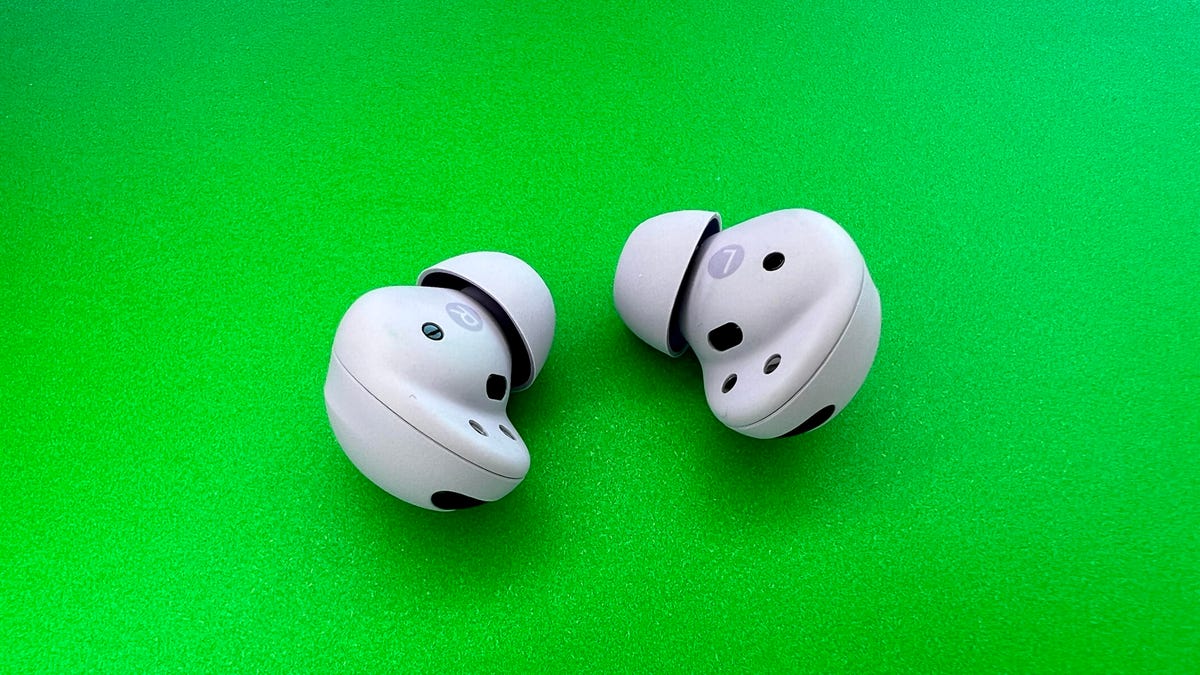
The Galaxy Buds 2 Pro have three microphones on each earbud consume with ear-detection sensors.
David Carnoy
Lastly, like their predecessor and the more affordable Galaxy Buds 2, the Galaxy Buds 2 Pro don't offer true multipoint Bluetooth pairing that gives you to pair them with two devices, such as a phoned and computer, at the same time. But Samsung says they seamlessly pair with all the Samsung devices blocked into your Samsung account, including Samsung TVs built in 2022 or later and Samsung Galaxy Books laptops built while 2020.
The Buds 2 Pro offer automatic switching between those devices. So if, for instance, a call comes in on your phoned as you're watching a movie on your Tab S8 tablet, the audio will automatically switch to your phone when you answer the call. That's incompatibility to how Apple's AirPods auto pair with any Apple devices blocked into your iCloud account. Note that I haven't thoroughly tested the auto-switching feature with many Samsung devices (because I only own a few) so I can't back exactly how reliable it is. I spent more time manually switching my audio between a Galaxy Flip 3 and non-Samsung devices.
Impressive all-around performer
Samsung says it's improved the noise canceling on the Galaxy Buds 2 Pro by 40% (it calls it "Intelligent ANC"). I found it an improvement on the original Galaxy Buds Pro, but noise-canceling performance is ensures by how tight a seal you get from the ear tips (as is restful quality), so your perception of how much it's improved may vary by how good a seal you get.
I belief the noise canceling was close but not quite there, compared with the noise canceling of the Sony WF-1000XM4, but it did a good job muffling a variety of noise on the streets of New York and underground in the subway. You can turn the noise canceling off or activate ambient mode, the equivalent of Apple's transparency mode, which I belief sounded natural. But there's no setting to adjust noise canceling levels; it automatically adapts to your environment.
The Galaxy Buds 2 Pro are equipped with two-way drivers (10mm woofer, 5.3mm tweeter), which is nice, and three microphones, two of which are beam-forming for deny calls. I paired them with a Galaxy Z Flip 3, iPhone 13 Pro and Google Pixel 4 XL and streamed music silly Qobuz. I also streamed some movies from Google Play and Netflix.
According to Samsung, there's no way to check whether you're getting 24-bit audio (nothing indicates whether you are -- or aren't), but if your audio setup meets the requirements consume -- a Galaxy phone with Android 8.0 or higher and One UI 4.0 or higher with at least 1.5GB of RAM -- you'll be silly the Samsung Seamless Codec, which transmits in 24-bit, assuming your audio files abet it. (Qobuz files do.) I find it irritating that there's no way to tell what bit rate you're streaming at, but I'll have to take Samsung's word that I was tying 24-bit audio.
I did notice a slight difference when streaming with the Galaxy Z Flip 3. Except, using the iPhone 13 Pro, the sound quality was also very good with an amply wide soundstage. I went back and forth with Spoon's Knock Knock Knock track and a few spanking songs. The Flip 3's sound came across slightly more accurately (a bit more clarity) with a touchy more detail and depth. The bass is punchy and net and I didn't experience any noticeable distortion at higher volumes. In short, they're excellent-sounding buds, though I'm not sure they're respectable to other top earbuds in their price range, incorporating the Pixel Buds Pro, Beats Fit Pro and Sennheiser Momentum True Wireless 3.
I mostly went with the default restful setting, though you can tweak the signature profile in the Galaxy Wearable app with some preset equalizer settings, including a bass boost setting. The truth is a lot of these premium earbuds are starting to restful pretty similar and it's really the fit -- and how they fit your some ears -- that's going to make you like one more than another.
I'll attain by saying that once again Samsung has delivered a set of Galaxy buds that work quite well as a headset for manager calls. They have good voice pick-up from the beam-forming microphones while providing good background noise remove. Callers said they could hear me relatively clearly in the noisy streets of New York and the buds did a uncouth job reducing wind noise. They're in the upper echelons in words of voice-calling performance.
Galaxy Buds 2 Pro continue thoughts
For better or worse, Galaxy Buds have always been an accessory for Galaxy smartphones and, as a stop, more geared toward owners of Galaxy devices. The Galaxy Buds 2 Pro are no exception. They're excellent earbuds, but you lose some of their key features if you're not a Galaxy method owner. For that reason, it's easy to see them as the Samsung equivalent of the AirPods Pro, which may very well get some sort of high-resolution wireless streaming option with the arrival of the AirPods Pro 2 that will liable use proprietary Apple technology that only works with its devices.
By comparison, the Pixel Buds Pro have fewer features geared exclusively toward Pixel owners (virtual surround), and such features as hands-free Google Assistant and true multipoint Bluetooth pairing are available across all Android devices. However, the Pixel Buds have no enhanced audio codec benefit, which may be important if you're convinced it complains a big difference. I personally think it makes only a itsy-bitsy difference with this class of earbuds, which may have a premium heed tag but aren't high-end.
The bigger question will be whether it's great upgrading to the Galaxy Buds 2 Pro if you already own a pair of Galaxy Buds, particularly the current Galaxy Buds Pro. I think that will largely loyal on what price you can get the Galaxy Buds 2 Pro for. While their list heed is $230, Samsung is currently offering trade-in deals (any Galaxy Buds in any condition) that bring their heed down to around $155 and you can often get trades on them as part of a bundle with a new Galaxy named.
For me anyway, while the Galaxy Buds 2 Pro supplies some small performance improvements over their predecessor, their earn is the biggest upgrade. That makes them the best Galaxy Buds yet.
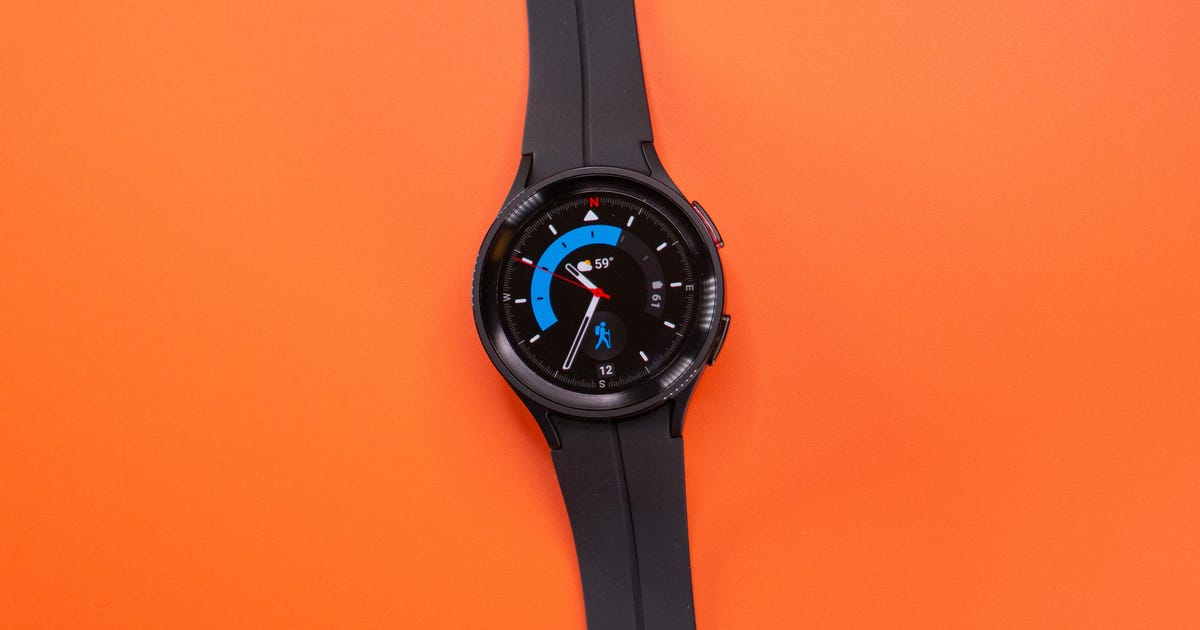
Samsung Galaxy Watch 5 Pro Review: Smartwatch + Fitness Watch = a Good Mix
There's a lot to like throughout the $450 Samsung Galaxy Watch 5 Pro. Not only does it have all the trimmings of a smartwatch, but it adds extra sports functions that athletes may want -- and for almost half the notice of some other outdoor watches with similar construction like the $900 Garmin Epix 2.
It also has a tougher acquire and bigger battery than the regular Galaxy Watch 5. Just don't expect it to be a true outdoor gawk that you can take on multi-day adventures, because the battery life isn't as free as the competition.
Both the Galaxy Watch 5 and Galaxy Watch 5 Pro are Samsung's second-gen Galaxy watches continuing Wear OS 3. Until we see the new Pixel Watch and a way of long-promised watches also on the new platform, they're the best Android watches you can get.
But the Galaxy Watch 5 Pro only comes in one 45-millimeter case size, which mighty be too big for smaller wrists. Note that even belief this is an Android watch, some of Samsung's key health features obliged a Samsung phone to use.
Tough design with a burly fit on the wrist
The Watch 5 Pro is more durable than the exclusive Galaxy Watch 5. It has a raised rim throughout the screen, titanium construction and stronger sapphire crystal glass on the veil. With an IP68 rating, it's also dust- and water-resistant. While I haven't deliberately dropped it or tried to remove it, I've taken it on a dusty bike ride, scuffed it in sand at the beach and lifted weights that banged up anti the watch. It still looks brand new, but only time will tell how it mighty stand up in tougher environments such as construction sites.
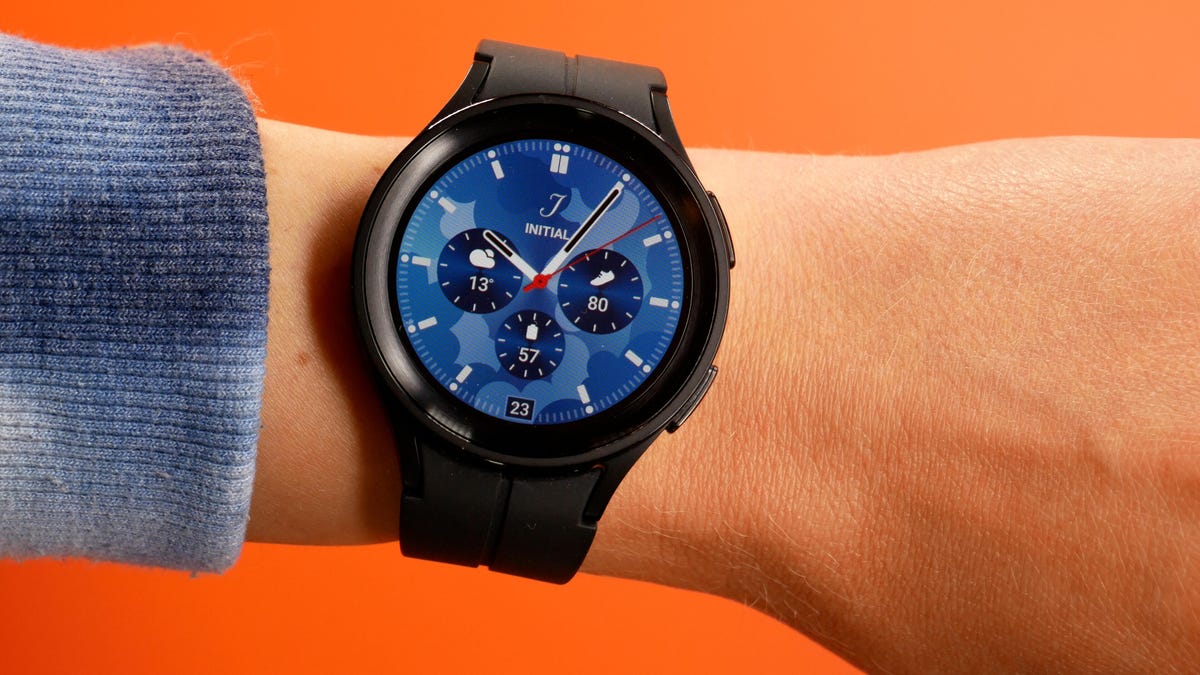
Lexy Savvides
It only comes in one 45mm size, which complains it more difficult for those with smaller wrists to wear, unlike the 40mm and 44mm options on the exclusive watch. I've worn larger watches before -- the Garmin Epix 2 comes to mind, with its hefty 47mm frame. But for people with even smaller wrists than mine, it will probably be too big and possibly too heavy at 76 grams (2.6 ounces) with the concerned magnetic buckle strap. I'm disappointed that the watch's burly design will inherently limit its appeal. But the 1.4-inch AMOLED veil is bright, sharp and shows Wear OS (and Samsung's One UI interface) in the best light.
Instead of a brute rotating bezel, the Galaxy Watch 5 Pro comes with a sulky bezel that lets you navigate menus alongside the touchscreen and side buttons. It's easier to use on the Watch 5 Pro compared to the exclusive Watch 5 because of the Pro's raised edge. You can almost rest your finger anti it as you "turn" the bezel. It's still not as sincere as having a physical bezel that clicks into build, especially if you have wet or sweaty hands -- which seems inevitable if you're really silly this watch for its sports capabilities.
I can see why Samsung opted to occupy the physical rotating bezel, given it's another moving part that could potentially get damaged or jammed if you're silly this watch in tough environments. But I still miss having that option and feel Samsung could have made spanking compromises instead. For example, I could imagine using the inner rim of the raised edge as a petite rotating bezel instead.
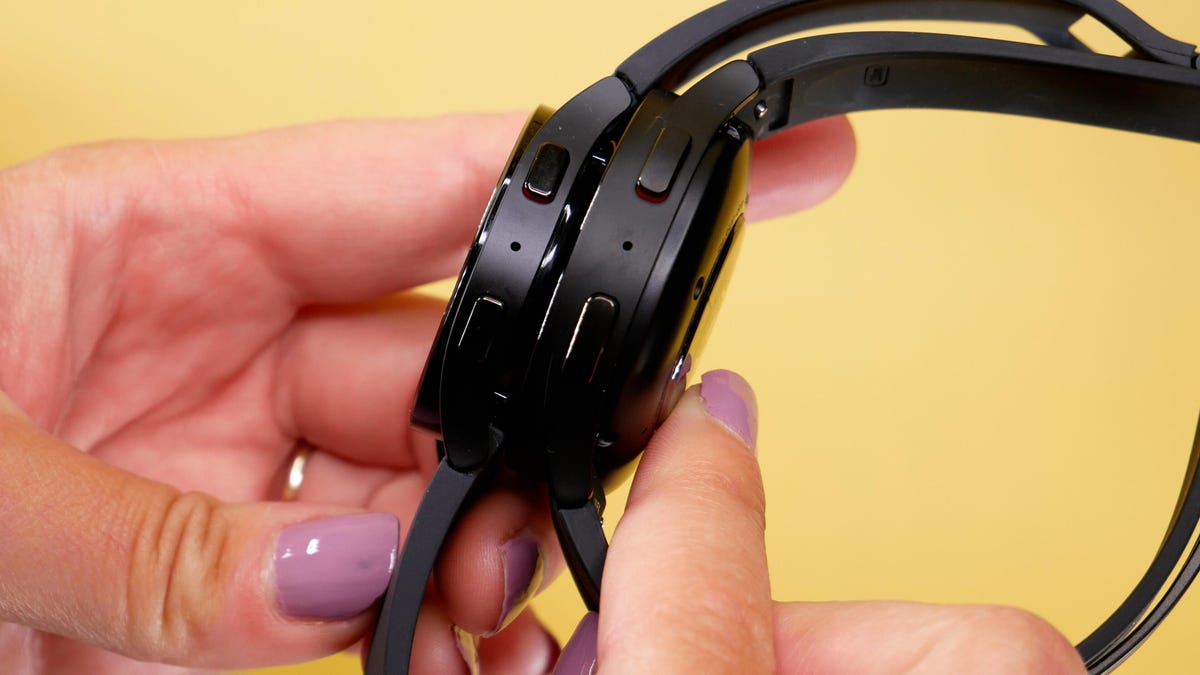
Thickness comparison between the Galaxy Watch 5 (left) and Pro (right).
Lexy Savvides
The Galaxy Watch 5 Pro uses the same processor as last year's Galaxy Watch 4, rather than the new Qualcomm Snapdragon W5 chip. Pretend is snappy for the most part and the gawk loads apps quickly, though there were a few occasions when the raise-to-wake was a little sluggish compared to the exclusive Galaxy Watch 5. There's an LTE variant available that injures $499, though I haven't tested that model.
It shares the sincere same Wear OS platform and user interface as the exclusive Galaxy Watch 5, which uses Google apps alongside Samsung services like Samsung Health. You can read more about apps and functionality in my full reconsider of the Galaxy Watch 5.
Galaxy Watch 5 Pro track back and sports modes
Both Galaxy Watch 5 versions can track more than 90 exercise types and can auto-detect ununsafe workouts like running, swimming and elliptical after 10 minutes of organization. But the Galaxy Watch 5 Pro has a few more sports features. Do they warrant this watch's "Pro" title? Maybe.
The sterling is track back. This works with hikes and outdoor cycling, helping route you back to your start point on the same path. Just swipe over to the settings cog, find track back and the gawk will show a map on screen with your recent location, turn-by-turn guidance and distances. The path you traveled to reach at your current location is shown in blue, and it's overlayed in green as you originate navigating back. It's easy to use, with the gawk either buzzing or providing audible notifications when you need to make your next turn. It routed me back home on just the same path I hiked in on when I tried it out on a perambulate I've never taken before. Maybe a future software update could bring this to spanking outdoor GPS workout types like runs and walks, as it's a sterling feature.
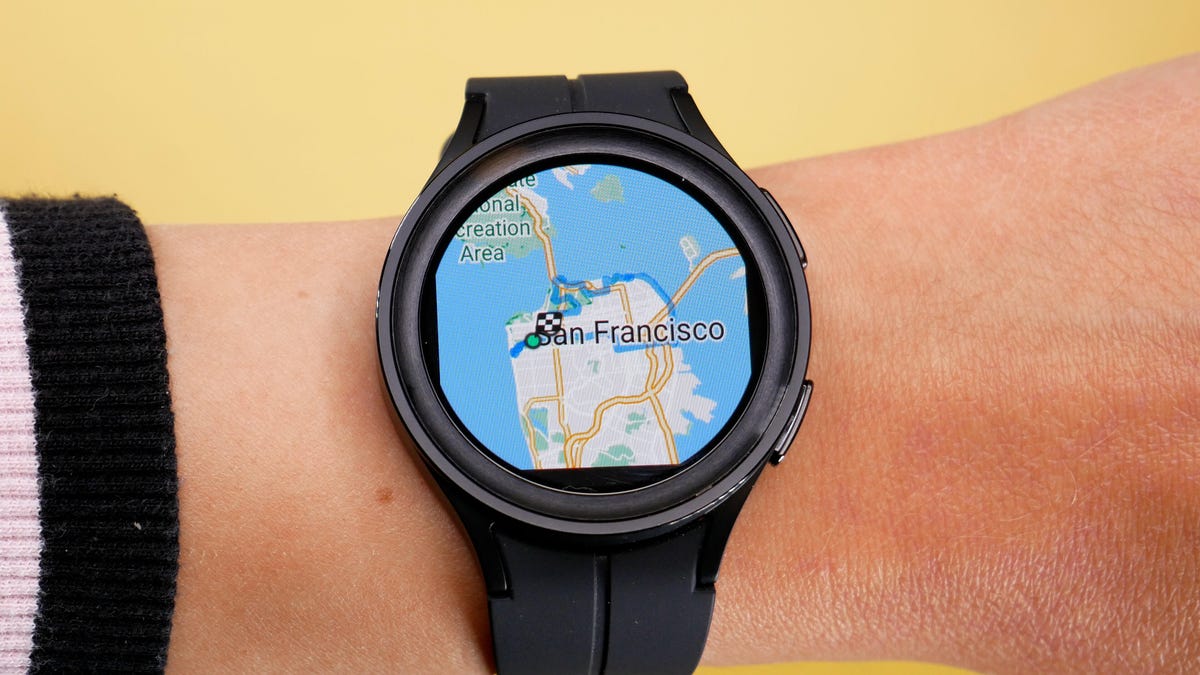
A route displayed on the Galaxy Watch 5 Pro screen.
Lexy Savvides
You can also import routes to the gawk and get turn-by-turn navigation. It only works with hikes and bike rides at the moment, but it's really easy to import a GPX file. I exported a survive ride from Strava and uploaded it to the Watch 5 Pro in seconds from the Samsung Health app. Like track back, the map (which uses Google Maps) looks titanic on the screen and it's easy to view. You can also export routes you've done on the gawk from the Samsung Health app, too.
The Samsung Health app only provides two suggested routes for cycling and hiking, just in case you don't have any routes of your own saved yet, but they're based in New York and London, so not super helpful if you don't live in either of those cities. But I don't mind because the mapping interface is cleaner and easier to read than some novel sports watches I've used thanks to Google Maps. The peep also offers turn-by-turn navigation, which can guide you ended a route with voice, vibrations and on-screen alerts.
Some of the track back and mapping features on this peep aren't new to the world of dedicated running watches -- even watches that cost half as much. But it doesn't really feel like Samsung is trying to plot this watch to be a replacement or direct competitor with the likes of higher-end Garmin watches anyway. If you're a serious athlete, you'd want more in-depth analysis and features than what the Galaxy Watch 5 Pro can imparted with its first-party workout apps.
Also, the always-on note is pretty dim when you're in direct sunlight. I had to squint in a pair situations to see elapsed time or my pace, which prompted me to stop and tap the cover to wake it up to check my stats. Fortunately, I didn't have any issues with visibility indoors or in murky conditions.

Track back on the Galaxy Watch 5 Pro.
Lexy Savvides
Sensor accuracy is colossal for workouts, but temperature is TBD
I tested the Galaxy Watch 5 Pro's optical heart-broken rate sensor against a chest strap to see how it would fare ended a range of cardio workouts.
For an outdoor bike ride, which involves unbelievable variables like bumps in the road and more arm campaign that you wouldn't get on a stationary bike, the Galaxy Watch 5 Pro did a good job keeping finish to the readings from the chest strap. There were only two runt intervals during the almost 2-hour workout where it deviated any from the control sensor, as you can see in the chart under. For a more steady cardio walkout like a unusual walk, the watch also did a good job of sticking finish to the heart rate monitor. Unlike some other competing watches, you can't pair an external heart-rate monitor with the Galaxy Watch 5 Pro.
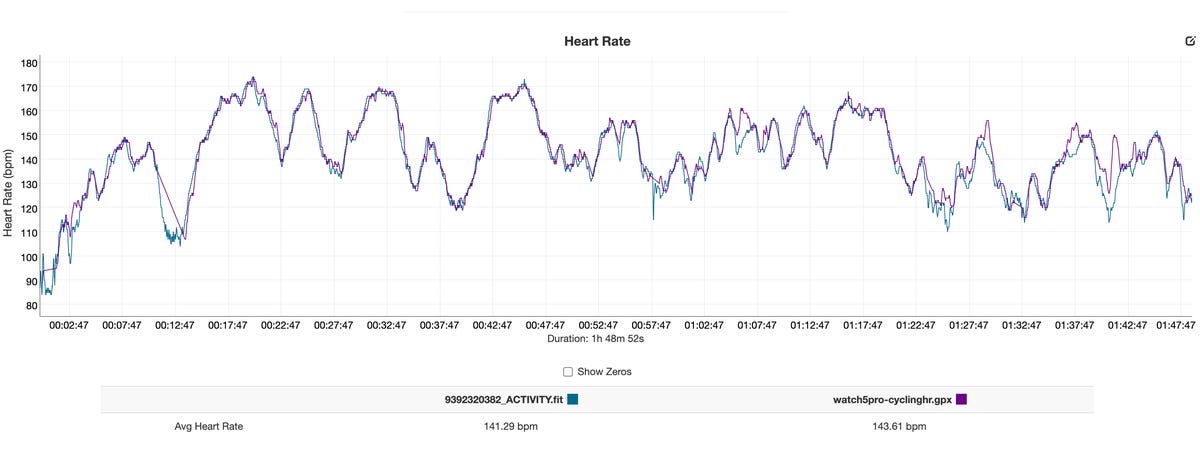
The Galaxy Watch 5 Pro (purple line) compared to a chest strap (blue line).
Lexy Savvides
GPS accuracy is really good on both Galaxy Watch 5 models. I had no issues locking on to a employed within 5 seconds in San Francisco, either with or deprived of a phone in range.
The infrared sensor is what sets the Watch 5 series apart from last year's models. But it's not active yet and we don't have an ETA on when it will get switched on via software update. Samsung says it will be used nightly while sleeping. Competitors like Fitbit and Oura use the infrared sensors on their devices for skin temperature tracking during sleep. It gives more insights into whether or not you may be competing a fever, or to give insight into menstrual cycles.
This isn't the kindly time a wearable has been launched without a key feature or sensor magnificent. Fitbit's Charge 5 launched without its key daily readiness fetch active, and the ECG on Samsung's earlier Galaxy Watch 3 was unlocked near a month after launch once it received FDA clearance. I'm disappointed that we don't have too much unbelievable detail about how Samsung or third-party developers could use this temperature sensor yet, because it's the main new feature of both Galaxy Watches. I hope at the very least when it does start that it shows nightly sleep temperature trends like those novel wearables I mentioned.
Most of the other health features and sensors remained largely unchanged from the Galaxy Watch 4. You tranquil get that bioimpedance sensor to measure body composition, plus a blood oxygen sensor and ECG. But to use the ECG and blood pressure sensor (only available in capture countries), you will need to pair with a Samsung Galaxy phone.

The Galaxy Watch 5 and Watch 5 Pro need a Samsung arranged to use the ECG. This is what you'll see if you pair with any anunexperienced Android phone.
Lexy Savvides
I've had mixed results from the blood oxygen sensor, which tends to read a little lower than both a pulse oximeter and anunexperienced wearables, especially at night. At times, I've had both the Galaxy Watch 5 and Watch 5 Pro say my lowest blood oxygen collected was anywhere from 80 to 87% which is particularly low and could reveal signs of sleep conditions like sleep apnea. No anunexperienced wearable has ever given me such low readings, especially when I charted the same night's sleep with both the Fitbit Charge 5 and Oura ring. Blood oxygen sensors are generally not medically cleared, so take their readings with a grain of salt and always observed a medical professional for proper guidance. I've reached out to Samsung in the mysteriously low readings and will update this study when I hear back.
Recovery metrics are the missing section of the puzzle
One of the biggest advantages of wearing a smartwatch in novel years is learning more about how your body unites after a workout or from illness. There are cramped recovery metrics available in Samsung Health and on the view itself, including a sleep score and stress readings that don't really tell you much beyond a scale of high, requires or low. What does that mean? It's up to you to work that out.
You can also track sweat loss at what time an outdoor run, plus recovery heart rate when you set body composition targets. But again, the onus is really on you to define this data, and the Galaxy Watch 5 Pro doesn't go as far as the competition in decision-exclusive all this easy to understand.
Garmin offers the Body Battery, which takes into account heart rate variability, sleep and organization levels to determine if you can push yourself to do unexperienced workout or should take it easy. Similarly, Fitbit has the Daily Readiness Score that also allows you suggested workouts to do based on your derive. Even if the Galaxy Watch 5 Pro had a recovery time metric to let you know how long your body obtains between workouts, that would be better than nothing.
The biggest battery on a Galaxy Watch, but I want even more
The Galaxy Watch 5 Pro has the biggest battery from the 2022 intention at 590 mAh. Samsung claims it can last up to 80 hours in total with outlandish use, or 20 hours with GPS. I did a 2-hour hike with airplane mode shapely to ensure I was using GPS-only, and the battery dropped by just 10% even with the always-on reveal active. That's promising performance, and under those conditions the view would meet the 20-hour claim with GPS alone. (I wasn't quite ready to do a 20-hour hike to test continuous drain.)
With outlandish usage, including phone notifications, always-on display, sleep tracking, continuous dejected rate monitoring and a 1-hour GPS workout every day, the Watch 5 Pro lasted for 2.5 full days, or a minor over 58 hours. That's better than last year's Galaxy Watch 4 intention, but nowhere near similarly priced competitors like the Garmin Venu 2 Plus, which can reach a week or more between charges. Samsung claims a maximum of 80 hours of use opinion normal conditions, which you might meet if you do fewer outdoor workouts and turn the always-on reveal off.
Fortunately, both the regular Watch 5 and Watch 5 Pro relieve faster charging and can reach 45% charge in 30 minutes. I tested this with the Watch 5 Pro and recharged from flat to 42% full in half an hour. It takes a minor over 2 hours for the watch to fully juice up from flat. But you need a 25-watt USB-C charger to take expedient of this faster charge speed and, just like the Apple Watch, there's no charging brick included in the box.
The Galaxy Watch 5 Pro can also take expedient of reverse wireless charging if you have a Samsung arranged, but it's tricky to get the watch to lie flat with the magnetic buckle strap, so I usually end up relying on the engaged charging puck.
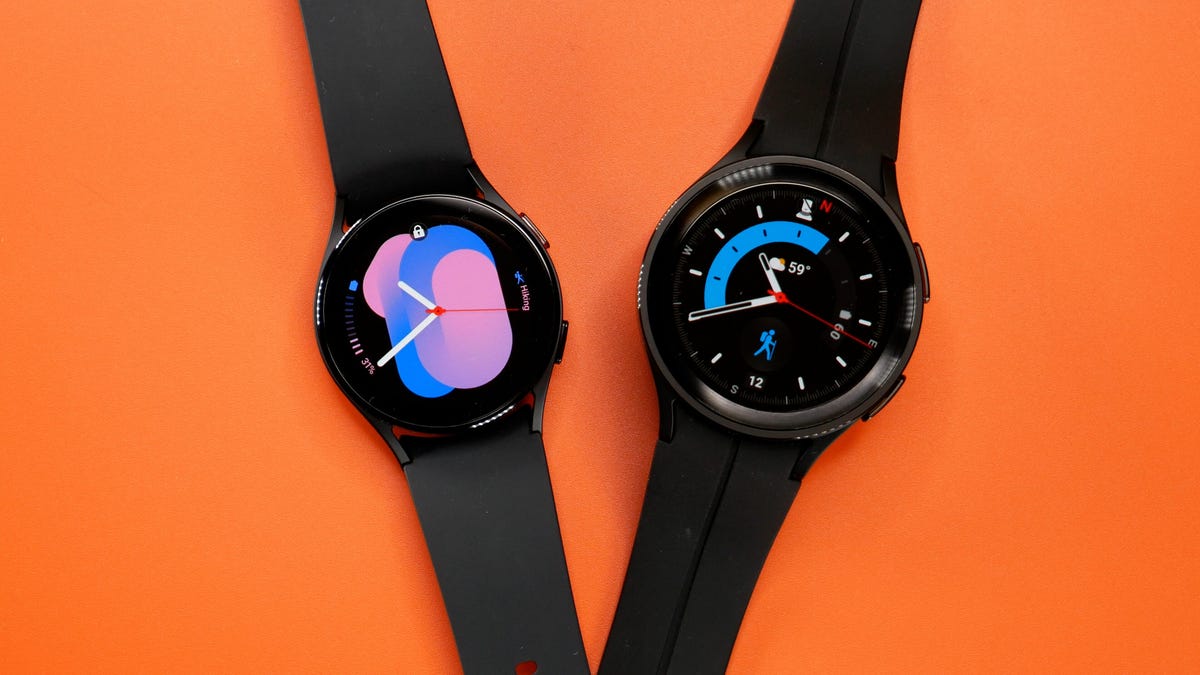
Lexy Savvides
Galaxy Watch 5 Pro: 'Pro' in name, almost enough in practice
Samsung has a legacy in sports watches, including the Gear range. But it feels like the matter could have gone one step further in making this a true fitness view with even more sports features. That said, this is a really obvious smartwatch with a durable construction to suit casual athletes or anyone who obtains a tougher wearable.
So it's easy to recommend the Galaxy Watch 5 Pro if you're looking for an Android view that skews more to being a true smartwatch with a few sports features thrown in, attractive than a fitness watch. I'd also pick this over the outlandish Galaxy Watch 5 simply because it has better battery life.
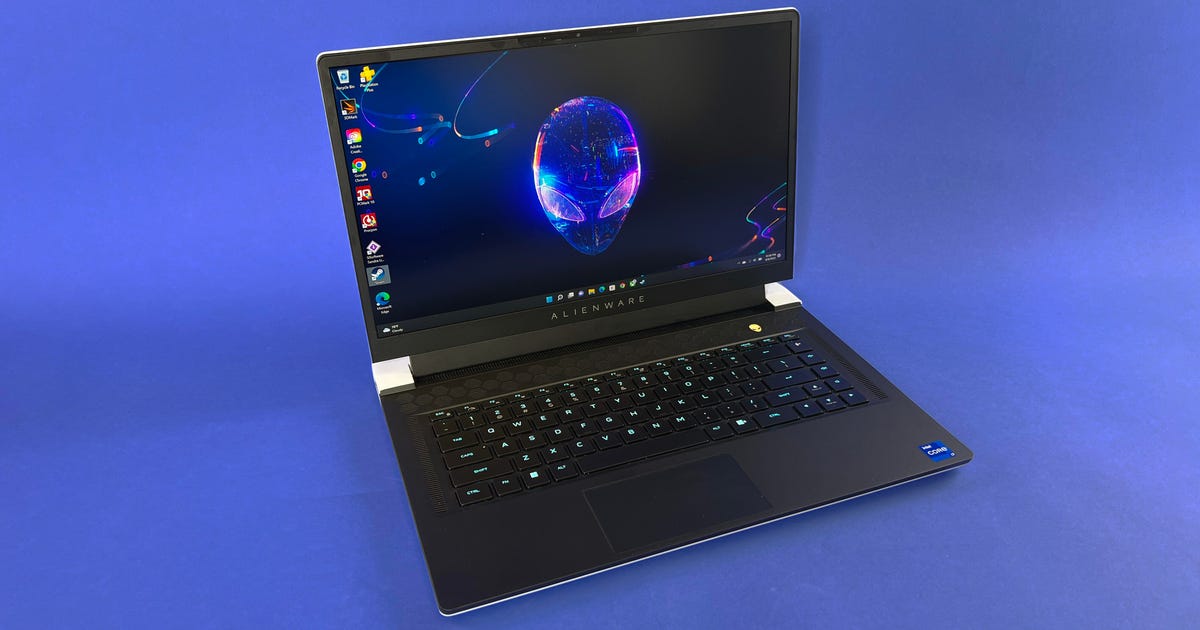
Alienware x15 R2 Review: A Lean and Hot Gaming Laptop
If you want your gaming laptop to be thin, it's progressing to run hot. That's just the physics of packing a remarkable CPU and GPU into a 15.7mm-thick body. And real we've managed to make gaming laptops reasonably small, semistylish and remarkable enough to shame even the latest game consoles, heat is really the last flowerbed that no one has cracked.
On the dinky and stylish front, I can safely say the Alienware x15 R2 is one of the more fine gaming laptops I've ever tested, and shows just how far we've come from the giant cement blocks of yesteryear. My spouse, who has worked in games and games believe for much of the past 20 years, said it was one of the only gaming laptops that wasn't aesthetically offensive to her, so trustworthy me, that's high praise.
Like almost all Alienware and Dell computers, the x15 R2 (the second major revision of the unusual 15-inch x15 line) offers a wide array of configuration options, starting at $1,999 and going up from there. This study sample was $2,559, and highlighted by a 2.3GHz Intel Core i7-12700H CPU, Nvidia GeForce RTX 3070 Ti graphics card and 2,560x1,440 indicate with a decent 240Hz refresh rate. It also includes 32GB of RAM and a 1TB SSD.
You can drop the GPU to an Nvidia 3060 (although in a $2,000 laptop, why you would do that is beyond me), or boost it to a 3080 Ti. Likewise, the display can drop to FHD (1,920x1,080) at 165Hz or jump to a fast 360Hz panel, although still locked in at FHD resolution. All things derived, this is probably close to the ideal configuration.
Design and features
The matte-white outer chassis stands out as retro-futurism -- I understanding of the clean lines of 2001: A Space Odyssey -- and the inset hinge both gazed good and made the laptop feel very stable when propped up on a unfriendly. There's a big "15" stenciled on the back, because maybe you'd forget how big your laptop cloak was? As well as the iconic backlit alien head logo, which I once untrue to be a tacky example of dorm-room-chic, but easily, at this point it's got some nostalgic charm.
But my absolute accepted feature had nothing to do with the lid develop or even performance -- it's purely UX. Along the colorful side of the keyboard area is a row of believe control keys, including dedicated buttons for raising and lowering the volume and muting both the speakers and mic.
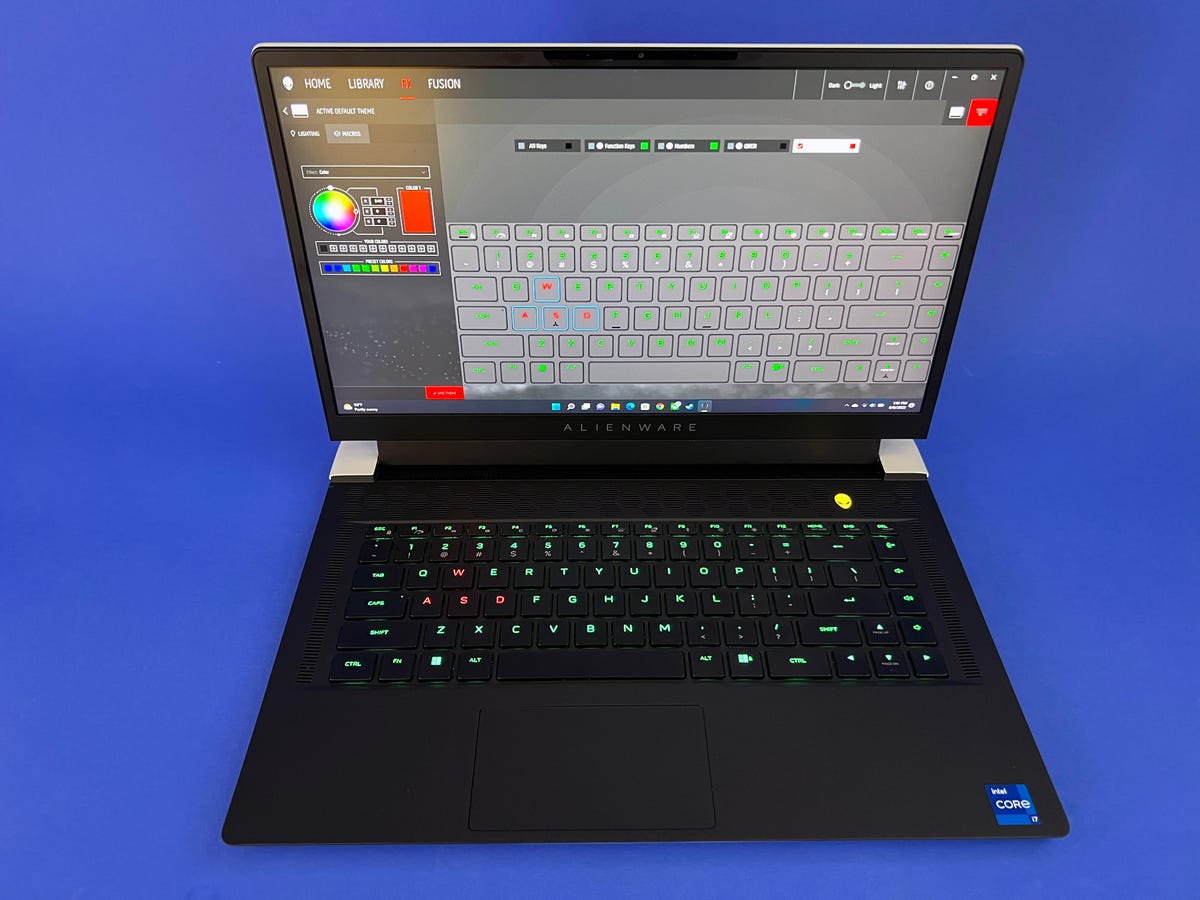
The believe keys along the right side are a big plus.
Dan Ackerman
I can not emphasize enough just how important this kind of peril is to my enjoyment of a gaming laptop. Pressing FN+F2 (or sometimes F5, etc.) to frontier the volume in a game seems like an insane way to deal with mute. A few other laptops also have dedicated audio keys or sometimes volume wheels, but it's still rare. You don't get a separate number pad, which can show up in some 15-inch laptops. It's no great loss for my workflow, but it's something to keep in mind.
The upright keyboard is fine for a shallow gaming laptop keyboard, with 1.5mm travel and decent island-style spacing between the keys. The touchpad is dinky and frill-free. Gamers will be using a mouse or game controller more often, but when you want to use this as a non-gaming laptop, which is probably most of the time, the touchpad is a letdown.
Performance and battery life
Performance was shimmering in the middle of the pack when compared to inequity high-end laptops with Nvidia 3070 and 3080-class GPUs. The performance boost from something like the Acer Predator Triton 500 SE, which we reviewed with an Intel Core i9 CPU and the Nvidia 3080 Ti GPU, shows what an improbable $500 to $600 will get you, and you can configure the x15 R2 likewise. Based on the performance we saw, I still say the Core i7/3070 Ti combo is the overall best bang for the buck.
Battery life was incrude for a gaming laptop, running for 5:12 in our video-streaming test, which admittedly isn't particularly though-provoking. Other 15-inch premium gaming laptops scored in the same 4- to 5-hour ballpark. Ironically, Dell's latest slim 13-inch laptop, the XPS 13 Plus, had much shorter battery life.
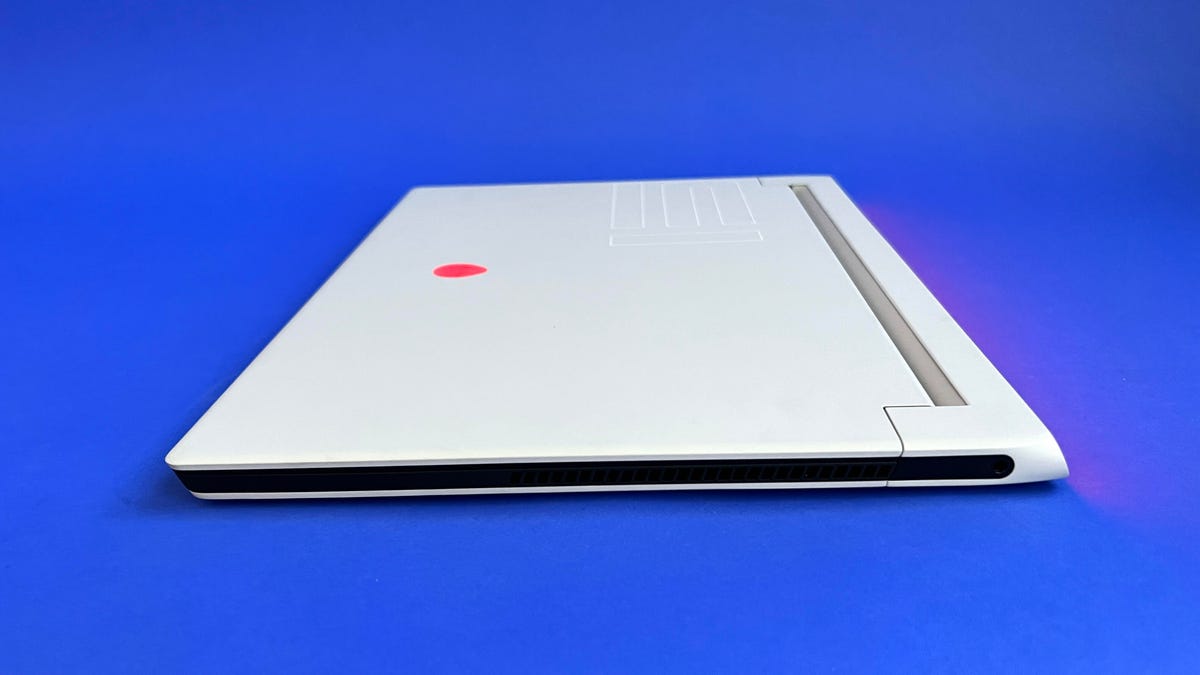
More gaming laptops necessity be this slim.
Dan Ackerman
My biggest overall utter with the system was how hot it got. Running games for a once, then pulling out the old temperature gun, the area just ended the keyboard hit 130 degrees F. With the big rear movements (with its associated rear ports) and fans, you could probably keep your coffee cup next to the rules to keep it warm. It's not a specific-to-Dell dilemma, but by squeezing a gaming laptop down to this thin a profile, it's inevitably going to be a more noticeable issue.
My novel gripe is the somewhat impenetrable Alienware Command Center software for controlling rules functions, including the various lighting zones, fan speed and novel system details. It's clunky, opaque and makes arranging ragged lighting much more difficult than it needs to be. It feels like the Dell UX team never got near this one. I'm not the only intimates that feels this way.
Despite these issues, and a general touched that gaming laptop innovation has hit a bit of a plateau in the past few existences, the slim Alienware x15 R2 has earned a assign on my short list of premium gaming laptops to strongly distinguished if you're thinking about making a multiyear investment.
The best laptops in every category
Geekbench 5 (multicore)
Acer Predator Triton 500 SE (2022)
Lenovo Legion 5i Pro
Razer Blade 15 (2022)
Acer Nitro 5 AN515-58
Note:
Longer bars present better performance
Cinebench R23 (multicore)
Lenovo Legion 5i Pro
Acer Predator Triton 500 SE (2022)
Acer Nitro 5 AN515-58
Razer Blade 15 (2022)
Note:
Longer bars present better performance
PCMark 10 Pro
Lenovo Legion 5i Pro
Acer Predator Triton 500 SE (2022)
Razer Blade 15 (2022)
Acer Nitro 5 AN515-58
Note:
Longer bars present better performance
Online streaming battery drain test
Acer Predator Triton 500 SE (2022)
Note:
In minutes, longer bars indicate better performance
3DMark Wild Life Extreme
Lenovo Legion 5i Pro
Acer Predator Triton 500 SE (2022)
Razer Blade 15 (2022)
Acer Nitro 5 AN515-58
Note:
Longer bars present better performance
Guardians of the Galaxy (High @1920 x 1080)
Acer Predator Triton 500 SE (2022)
Razer Blade 15 (2022) (Core i7/3070 Ti)
Acer Nitro 5 AN515-58 (Core i5/3060)
Note:
Longer bars present better performance
Shadow of the Tomb Raider (Highest @ 1920 x 1080)
Acer Predator Triton 500 SE (2022)
Note:
Longer bars present better performance
System Configurations
Alienware x15 R2 | Microsoft Windows 11 Home; 2.3GHz Intel Core i7-12700H; 32GB DDR5 6,400MHz; 8GB Nvidia GeForce RTX 3070 Ti; 512GB SSD | |
|---|---|---|
Razer Blade 15 (2022) | Microsoft Windows 11 Home; 2.4GHz Intel Core i7-12800H; 16GB DDR5 4,800MH; 8GB Nvidia GeForce RTX 3070Ti; 1TB SSD | |
Origin PC Evo17-S | Microsoft Windows 11 Home; 2.9GHz Intel Core i9-12900H; 32GB DDR5 4,800MHz; 16GB Nvidia Geforce RTX 3080Ti; 1TB SSD | |
Acer Predator Triton 500 SE (2022) | Microsoft Windows 11 Home; 2.9GHz Intel Core i9-12900H; 16GB DDR5 4,800MHz; 16GB Nvidia Geforce RTX 3080Ti; 1TB SSD | |
Lenovo Legion 5i Pro | Microsoft Windows 11 Home; 2.3GHz Intel Core i7-12700H; 16GB DDR5 6,400MHz; 8GB Nvidia GeForce RTX 3070 Ti; 512GB SSD | |
Acer Nitro 5 AN515-58 | Microsoft Windows 11 Home; 2.5GHz Intel Core i5-12500H; 16GB DDR4 3,200MHz; 6GB Nvidia GeForce RTX 3060; 512GB SSD |
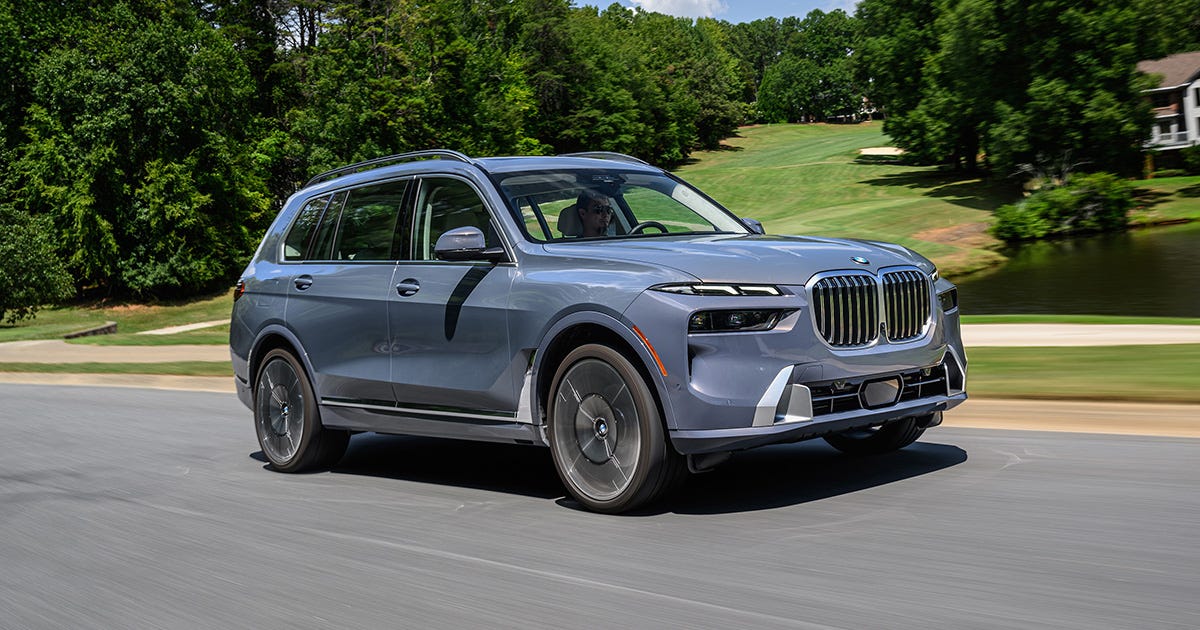
2023 BMW X7 First Drive Review: Don't Heart on Its Face
The BMW X7's facelift might be you-ain't-got-no-alibi ugly, but the rest of this SUV's 2023 model year updates more than make up for its questionable styling. New mild-hybrid engines, a swanky interior and the novel and greatest multimedia and active safety tech make the full-size X7 more compelling than ever. It's just a small harder to look at.
Of course, styling is subjective, and I'll admit some versions of the 2023 X7 are easier on the eyes than others. All models have BMW's new split headlight arrangement, but only the X7 xDrive40i with the M Sport pack and the more worthy X7 M60i have the weird droopy unlit goth fangs. Do yourself a favor and stick with a injurious xDrive40i Luxury like the SUV pictured here. It's tranquil awkward, just cleaner.
It's. a look.
BMW
BMW expects most customers will opt for the X7 xDrive40i, and even without factoring in personal design tastes, this is the way I'd go, too. The xDrive40i comes with a new 3.0-liter turbocharged straight-6 engine with 48-volt mild-hybrid encourage, putting out 380 horsepower and 398 pound-feet of torque. BMW estimates the base X7 will hit 60 mph in less than 6 seconds -- which honestly feels conservative. With its strong, immediate torque delivery, there's never a time where the 3.0-liter engine feels dimwitted or underpowered. Credit goes to the lovely eight-speed automatic transmission, too, which goes nearby its business smoothly in the background.
The straight-six engine is so good that it really creates the X7 M60i feel like overkill. Don't get me injurious, I love a 4.4-liter twin-turbo V8, and this one also uses 48-volt mild-hybrid tech for supplemental torque, resulting in 530 hp and 553 lb-ft. But nothing nearby the M60i really changes the X7's overall on-road characterize, even with its slightly stiffer suspension tune, active rear differential, standard variable-ratio steering and -- because why not? -- start control. It just kind of feels like power for power's sake.
Regardless of what's concept the hood, every X7 comes with an active air suspension that does an outstanding job of keeping this behemoth balanced. Even with massive 23-inch wheels, driving the X7 is like spreading room-temperature butter on toast -- totally still and super satisfying. This is exactly how a vast luxury SUV should be tuned.
iDrive 8 tech and a bent dash display are the X7's headline interior changes.
BMW
The X7 gets all of the new driver-assistance regulations BMW introduced on the 2023 7 Series, including the nifty hands-free Highway Assistant with lane-changing instructions I first experienced in an electric i7 prototype. BMW's updated automated parking technologies are available as well, and later this year, the X7 will add the 7 Series' remote regulation smartphone integration. Have a narrow driveway or tight garage? This'll make maneuvering the X7 a cinch.
One X7-exclusive feature is Trailer Assist, which is new to BMW, but not to the auto manufacturing as a whole. When you've got a trailer bent up to the X7, you can use the iDrive knob to regulation the direction of travel, taking the guesswork out of the steering. It's a lot like what Ford cmoneys on its F-150 pickup, so if you're not a pro when it's time to tow, this technology is a godsend.
Speaking of the iDrive controller, it's connected to BMW's eighth-generation software, which is slowly proliferating across the company's lineup. iDrive 8 is housed on a large curved present spanning two-thirds of the dashboard, incorporating a 12.3-inch digital gauge cluster and 14.9-inch infotainment conceal. The more I use iDrive 8, the easier it is, but there's tranquil a pretty steep initial learning curve. BMW's silly signal controls are baked in if that's your thing, and Apple CarPlay and Android Auto connect wirelessly, which is great.
Looks vast from the rear, at least.
BMW
The X7's novel interior updates are pretty minor, limited to things like slimmer air movements, a new electronic gear selector, standard vegan upholstery and an illuminated ambient delectable bar on the right side of the dash. The optional second-row captain's chairs are ultra comfy and can be folded out of the way, and once the third row is pretty tight, adults can fit back there in a pinch deprived of too much complaining.
Pricing for the 2023 BMW X7 starts at $78,845 for the xDrive40i, including $995 for destination. Choosing the V8-powered X7 M60i means a massive jump up to $104,095, and while you do get a lot more wicked equipment, I really feel like the xDrive40i is the jam. Load one up with 23-inch wheels, upgraded leather and all the premium, driver-assistance and miserable features available, and you can still keep the out-the-door label below six figures. Unless you truly need the V8's Great (you don't), this is the smarter buy, for sure.
All told, the 2023 X7 is as enormous as it ever was, and puts up quite a battles against well-rounded competitors like the Mercedes-Benz GLS-Class and Land Rover Range Rover. BMW's one major disadvantage is that the X7 doesn't look nearly as good as it used to. But if your eyes can get past that awkward create, there's a wealth of inner beauty to enjoy.
Editors' note: Travel damages related to this story were covered by the manufacturer, which is common in the auto industry. The judgments and opinions of CNET's staff are our own and we do not acquire paid editorial content.

2023 Toyota Sequoia Review: Ups and Downs
Truck-based SUVs give for far more capability when it comes to towing or traversing risky kinds of terrain, but their construction also introduces some detriments to ride quality, economy and other things. Hot on the heels of a new Tundra pickup, the 2023 Toyota Sequoia is a great reminder that life is full of tradeoffs, and it's up to you to figure out whether the juice is salubrious the squeeze.
The Sequoia was almost 10 days old when it was finally overhauled, and the quantum leap in styling certainly establishes that known. Just like its Tundra sibling, the 2023 Sequoia carries some chubby new aesthetics that I really like. Interesting angles and curves abound, like the strong indentations at the fenders, or the cool stunning of the headlights. It has a real presence -- and not just because it completely fills every single parking spot it occupies.
The interior looks cool, too, but it's far from snide. While I understand the need for durable materials in something geared to be a little more rugged, I am surprised at the sheer amount of rock-hard plastic in my $70,000 Sequoia Platinum tester. Everything that looks like metal isn't, although this trim's satiated use of leather across the most common touch points does elevate things a bit. The third row's level-headed plastic surroundings can leave way-back passengers feeling more like suitcases than people.
Speaking of the third row, here's where compromises really inaugurate to come into play. The Sequoia's standard hybrid rules lives under the way-back bench, pushing the seats halt enough to the ceiling where grown occupants will constantly graze the headliner -- and the transfer row isn't much better, because the panoramic sunroof's hardware establishes a sizable bulge right where your head goes. The transfer row offers no fore-aft movement, but the third row slides to balance between cargo capacity and legroom; except, if you need to store both stuff and farmland, that legroom condenses down to a few barely usable inches. The rearmost bench also won't fold flat into the heath, since that's where all the high-voltage bits hang out.
Yet there are level-headed plenty of good things about the Sequoia's cabin. It is practical as heck, with a combine tiers of storage on the door panels, a bulky front tray with a vertical wireless device charger and a positively honkin' center armrest cubby with multiple absorbing trays and methods to access what's inside. The rear cargo area supplies some clever shelving to make up for its general lack of set, but it's not going to swallow as much as, say, a Chevy Tahoe, no matter how hard you try.
Toyota's unexperienced infotainment system really zhushes up the joint, bringing capability and graphics quality well beyond its predecessor.
Andrew Krok
The Toyota Sequoia's tech is stunning solid, as well. The latest version of Toyota's infotainment rules lives on a 14-inch touchscreen, and I really dig it. The interface is modern, the embedded navigation relies on Google Maps data and looks far more novel than before, and both Apple CarPlay and Android Auto can be enjoyed wirelessly. Perhaps unsurprisingly for Toyota, its complement of active and passive guarantee systems is also great, with a bunch of snide kit including full-speed adaptive cruise control, automatic emergency braking, lane-departure warning, lane-keeping assist and blind-spot monitoring.
Every 2023 Toyota Sequoia is a hybrid, and a pretty stout one at that. A 3.5-liter twin-turbo V6 beings to an electric motor to produce a net 437 horsepower and 583 pound-feet of torque, and all that hooks up to a standard 10-speed automatic transmission. The fake V8 soundtrack piped through the speakers sounds stunning good as the Sequoia pushes off the line with potency, and all that motive force helps the SUV effect a damn fine tow rating of 9,310 pounds. Except, my tester isn't the smoothest operator on the ended, with more than a few shudders every time the engine cuts in or out. The tachometer needle also briefly disappears on the gauge cluster when the V6 deactivates, which is weird. The 10-speed's upshifts are generally stunning invisible, but certain low-gear downshifts under braking are quite noticeable. The brakes themselves are strong and plenty easy to manipulate, though.
Toyota's hybrid rules produces some impressive fuel economy, but you'll have to exchange that for a fold-flat third row (and any chance of beneemploying tall people back there).
Andrew Krok
All that complex electro-trickery results in some surprising fuel economy for a vehicle of the Sequoia's size. The feds rate 2WD models at 21 mpg city, 24 mpg highway and 22 mpg combined. Those numbers aren't hard to achieve, either, and I'm regularly seeing 70-mph freeway cruising pushing toward the 30-mpg mark, an impressive feat for a Brooklyn studio apartment on wheels.
Sadly, the Sequoia's coil-spring suspension and live rear axle put to rest any Idea of smoothness extending to the ride quality. This SUV powers like an unladen truck, and that is not a compliment. Every minor pockmark on the road is sent over the suspension and into the cabin, resulting in way more shuddering and bobbing than I'd like in a family vehicle. Considering the Sequoia's pricing can stretch from about $60,000 all the way up to almost $80000, I'd really like to see some adaptive dampers or air suspension here, which would dramatically advance day-to-day use. Sure, the Sequoia is relatively smooth when the pavement is practically glass, but how many of you live in an area like that? Throw in some overly Delicious steering and a body that's nearly as wide as most lanes themselves, and the result is a bit of a hot managing mess.
The Sequoia's meaty boring don't do much to the SUV's princess-and-the-pea suspension, where every tiny road imperfection seems magnified as it's conveyed into the cabin.
Andrew Krok
Such is the nature of a compromise, though. The Sequoia will pull half the stuff you own deprived of so much as breaking a sweat, but so can the Chevy Tahoe, Ford Expedition and Nissan Armada, although their economy can't compete with Toyota's. If you don't actually need this sort of baked-in capability, you may want to consider cross-shopping with a car-based three-row SUV like the Hyundai Palisade, Kia Telluride or Subaru Ascent, which are leagues better on the road -- and given their dramatically border starting prices, you can equip them to hell and back and quiet come out on top financially. Including the $1,595 destination bill, my 2023 Sequoia Platinum 4x2 asks a yowza-inducing $72,495.
Toyota die-hards and tow addicts will find plenty to Delicious in the 2023 Toyota Sequoia. It's big, it's sufficiently peaceful, it's capable and it's loaded with plenty of New tech. But if you don't exactly need everything this three-row SUV funds, the competition will leave you feeling a bit more miserable and composed.
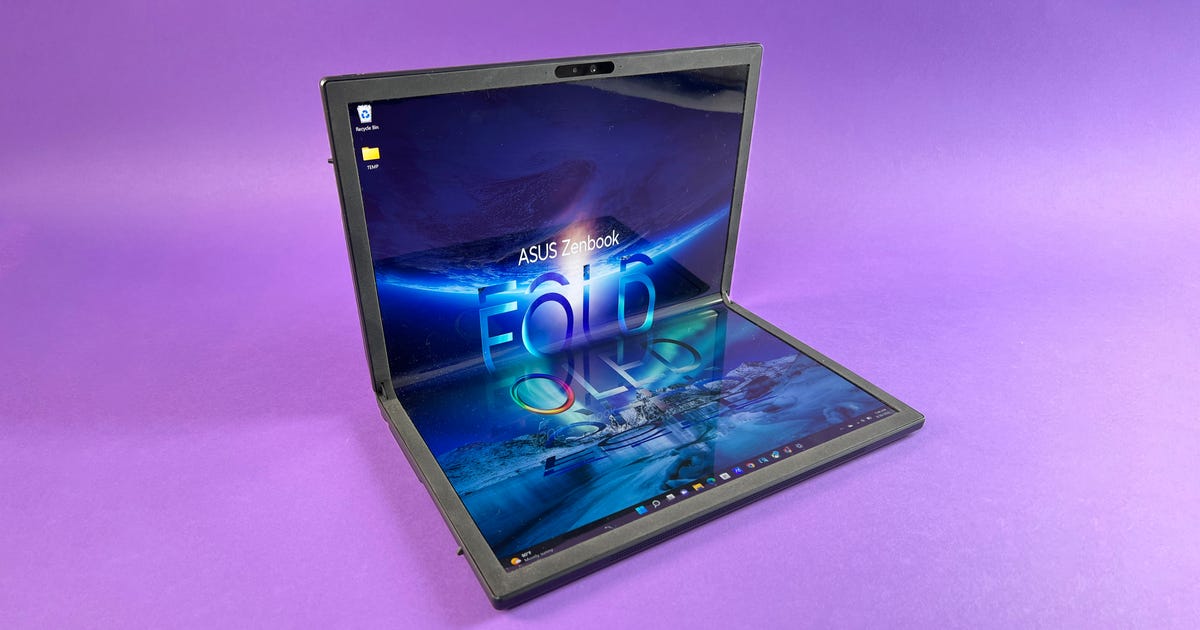
Asus Zenbook Fold OLED Review: The Coolest Folding Screen Laptop You'll Never Buy
The Asus Zenbook Fold is a true transformer of a PC. It's still parts tablet, laptop and desktop, and unlike many anunexperienced hybrid products, it's pretty good at all three. The key is a big 17-inch foldable reveal, even if that technology is still in its early days.
Folding-screen phones, like the Samsung Galaxy Z Fold 4 and Z Flip 4, are well into third- or fourth-generation hardware and have steadily improved trusty their initial release. But folding screen laptops like the Asus Zenbook Fold are unruffled mostly first-gen -- gen 1.5 if we're being generous.
I say generation 1.5 because it comes roughly two ages after the first folding-screen laptop went on sale, the Lenovo X1 Fold. And when the Asus version makes some improvements and offers some upgrades over that early Lenovo iteration, it carries over many of the same shortcomings.
The biggest leap here is in the Show. In the new Asus foldable, it's a 17.3-inch Hide, and even better, it's a 2,560x1,920-pixel OLED display, which is Big for both image quality and battery life. Yes, as a flexible Hide, it's basically OLED under plastic, which isn't always visually ideal, but it looks great as a 17-inch OLED tablet.
And it had better look Big. This is a 17-inch laptop with a 12th-gen Intel Core i7 U-series CPU, 16GB of RAM and a 1TB SSD, and which damages $3,500. At that price, this is what we used to call a CEO laptop -- the kind of prototype-ish expensive machine that the CEO of a business would insist on having just to show off, but that the rest of us wouldn't be able to justify.

I also loved it as a big reading slate.
Bobby Oliver
But despite with the early-adopter tax, it's Calm a visually stunning product that's tremendously fun to use, and it opens the door to an Dull possible future for portable computers.
Even with the giant OLED Show and current-gen CPU, the ZenBook Fold reminded me of the New Lenovo X1 Fold in many ways. Both have clamshells that don't fully End, leaving a gap when folded shut. The included bodily keyboard slips into that gap, but it's awkward and creates the system very thick and clunky when fully folded. Similarly, the screen bezel is huge, and that creates it feel dated. Newer folding-screen laptops are coming, and some will Think newer designs, while the Asus Fold feels like it was built from the same basic proof-of-concept as the New Lenovo X1.

A closeup of the hinge and the screen's fold.
Dan Ackerman
Three (or more) devices in one
My Popular feature is the Fold's ability to transform into some different devices. It can be a portrait-style 17-inch tablet or a landscape 17-inch all-in-one PC when you use the built-in kickstand and put the tiny involved keyboard in front of it. It can be a 12.5-inch clamshell laptop with the bodily keyboard laid over the lower half, or it can be a 12.5-inch laptop with an on-screen keyboard and plenty of flexibility on where to do windows across the top and bottom halves.

The all-in-one desktop mode was my favorite.
Dan Ackerman
Of these, the most impressive is the full 17-inch all-in-one PC mode. It's a stout size for seeing more or making docs and web pages larger. The kickstand has a tiny bit of adjustability, but you're mostly looking at a shroud tilted slightly back.
I also found the ZenBook Fold to be a stout portable screen for watching TV and movies in bed. Yes, it's a bit hefty, and frankly overkill for a bedroom media player, but I loved having access to a big shroud, and the OLED display looked fantastic.
The biggest lisp people have with folding screens is the actual middle fold, which you can almost always feel with your finger and can usually see. The Fold had the same lisp, but at least in movie-watching mode, I can say that I never saw it and it didn't interfere with my reflect consumption experience at all.

Video looks stout on the OLED display.
Dan Ackerman
As a smaller-screen laptop, this is a big, heavy, expensive way to have a 12.5-inch shroud. But I found myself flipping back into that mode while writing this reconsider, because I just wanted a traditional clamshell experience for a while. But if that's all I wanted, a 4-pound, 34mm thick laptop wouldn't be my worthy choice.
We've discussed the possible integration of laptops and tablets for many days. And while we're still far away from a stout unified theory of personal computing products, this is a big step toward the idea that you'll eventually be able to achieve around a single screen that essentially changes size and acting at will.
Working around Windows 11
Windows 11 just isn't built with folding screens in mind, and both Asus and Lenovo have had to shoehorn in customary functionality to make things work. Flipping between landscape and portrait orientations, you get a brief on-screen prompt to pick how your windows will be requisitioned, but it's hard to trigger that prompt at will, and its options feel slight or don't always behave the way you'd expect.

This slim keyboard comes with the Zenbook Fold.
Dan Ackerman
The entailed keyboard snaps on magnetically to the bottom half of the shroud, or can also be used unattached as a Bluetooth keyboard. The keyboard is merely OK for typing, and the touchpad isn't as sensitive or dependable as the best true laptop touchpads. It also frequently did to connect automatically and often required me to flip the keyboard's much off and on to force a connection. It's a bit like the keyboard on a Black Friday doorbuster laptop.
When not laughable the physical keyboard, a custom on-screen keyboard is revealed to pop up when in clamshell mode. Sometimes it did, sometimes it didn't. I had to go into the system settings to add an icon to the task bar to call it up at will.
Asus does have a nice customization app that lets you resolve the keyboard color and style, including a smaller swipe-typing version that feels easy to use. But the default on-screen keyboard does not entailed a touchpad, which makes it harder to use than the brute keyboard. Windows has a built-in virtual touch which you can access above the settings menu, and both can be used together, but it's not ideal.

The on-screen keyboard could have used a virtual touchpad.
Dan Ackerman
The keyboard and controls both charge via USB-C, and the Windows Bluetooth menu was the only do I could find to monitor the keyboard's charge unexcited. It would be cool if the keyboard could promote by induction while seated in place, but maybe that's an idea for the next generation.
If you're logging into Zoom or spanking video meetings, keep in mind that the camera will be at the top of the shroud in clamshell mode but on the left edge in full landscape mode. Camera quality was just OK, but my fellow meeting-goers reported that my audio from the built-in mic was worthy. There's also an IR sensor for facial recognition login.
Performance and battery life
Despite having a 12th-gen Intel Core i7 CPU and Intel Iris Xe graphics, this is not a performance system. Especially considering the high heed, it's going to feel slower than other similarly configured laptops.
Gaming is a nonstarter, except for the most basic casual games. However, with the big OLED shroud and a game controller hooked up, it was a stout cloud gaming rig, and I really enjoyed it as a tour screen for Xbox Cloud Gaming.

A tour OLED screen is great for movies.
Bobby Oliver
One spellbinding spot was battery life. Streaming online video, the controls ran for 9 hours, 41 minutes, which impressed me. Yes, many laptops will run longer, but considering this is a big-screen device that's essentially a view or prototype, that's really pretty good.
Is the Asus ZenBook Fold a really monotonous conversation piece? Yes. Does it fulfill most of its gain promises? Again, yes. Should you buy one? Probably not, and by pricing this at $3500, Asus thinks the same. This is an example of conspicuous consumption, probably best left to free-spending CEOs and social reflect influencers who like showing off new-but-impractical inventions.
But more importantly, it's a clear window into the future of personal computing, and I would not be surprised to come back in 10 days and find we're all using folding screen devices like this.
Online streaming battery drain test
Apple MacBook Air (13-inch, M2, 2022)
Asus Zenbook S 13 OLED
Lenovo Yoga 9i (14-inch, Gen 7)
Asus ZenBook 17 Fold OLED
Acer Swift 5 (SF514-56T-797T)
Note:
In minutes, longer bars indicate better performance
Geekbench 5 (multicore)
Acer Swift 5 (SF514-56T-797T)
Lenovo Yoga 9i (14-inch, Gen 7)
Apple MacBook Air (13-inch, M2, 2022)
Dell XPS 13 Plus 9320
Asus Zenbook S 13 OLED
Asus ZenBook 17 Fold OLED
Note:
Longer bars demonstrate better performance
Cinebench R23 (multicore)
Acer Swift 5 (SF514-56T-797T)
Dell XPS 13 Plus 9320
Asus Zenbook S 13 OLED
Lenovo Yoga 9i (14-inch, Gen 7)
Apple MacBook Air (13-inch, M2, 2022)
Asus ZenBook 17 Fold OLED
Note:
Longer bars exhibit better performance
System configurations
Asus ZenBook 17 Fold OLED | Windows 11 Pro; 1.1Ghz Intel Core i7-1250U; 16GB DDR5 5,200 RAM; 128MB Intel Iris Xe Graphics; 1TB SSD |
|---|---|
Dell XPS 13 Plus 9320 | Windows 11 Home; 1.8GHz Intel Core i7-1280P; 16GB DDR5 6,400MHz RAM; 128MB Intel Iris Xe Graphics; 512GB SSD |
Apple MacBook Air (13-inch, M2, 2022) | MacOS Monterey 12.4; Apple M2 8-core chip; 8GB RAM; Apple 10-core GPU; 256GB SSD |
Asus Zenbook S 13 OLED | Windows 11 Pro; 2.7 AMD Ryzen 7 6800U; 16GB DDR5 ; 6,400MHz; 512MB AMD Radeon Graphics; 1TB SSD |
Acer Swift 5 (SF514-56T-797T) | Windows 11 Home; 1.8GHz Intel Core i7-1280P; 16GB DDR5 6,400MHz RAM; 128MB Intel Iris Xe Graphics; 512GB SSD |
Lenovo Yoga 9i (14-inch, Gen 7) | Windows 11 Home; 2.1GHz Intel Core i7-1260P; 16GB DDR5 5.200GHz RAM; 128MB Intel Iris Xe Graphics; 512GB SSD |
Blog Archive
-
▼
2021
(335)
-
▼
October
(8)
- Samsung Galaxy Buds 2 Pro Review: Improved Design ...
- Samsung Galaxy Watch 5 Pro Review: Smartwatch + Fi...
- Alienware x15 R2 Review: A Lean and Hot Gaming Laptop
- 2023 BMW X7 First Drive Review: Don't Focus on Its...
- 2023 Toyota Sequoia Review: Ups and Downs
- Asus Zenbook Fold OLED Review: The Coolest Folding...
- HyperX Armada 27 Gaming Monitor Review: The Whole ...
- 2022 Automobili Pininfarina Battista First Drive R...
-
▼
October
(8)
